本文解析YOLOX结构并基于Paddle构建网络。YOLOX改进自YOLOv3,含Decoupled Head等改进。网络分主干CSPDarknet、PAN Head、YOLO Head。文中构建各组件,如ConvBlock等,组装成各部分并测试,验证了网络结构正确性,训练预测后续讨论。
☞☞☞AI 智能聊天, 问答助手, AI 智能搜索, 免费无限量使用 DeepSeek R1 模型☜☜☜
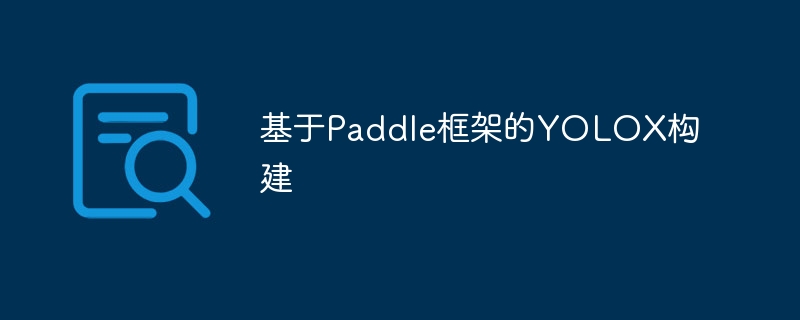
本Notebook对YOLOX的网络结构进行了解析,并采用PaddlePaddle框架对于YOLOX的网络结构进行了构建。
注:本Notebook仅讨论网络的构建部分,网络的训练、预测过程将在后续NoteBook进行讨论。
YOLOX是旷视科技(Megvii)在YOLOv3基础上改进的。主要改进的部分在于 Decoupled Head、Anchor Free、SimOTA、Data Aug。另外为了yolov5对比,主干网络引入了yolov5的FOCUS、CSPNet、PAN Head、SiLU激活。
Decoupled Head是学术领域一阶段网络的标准配置。然而,以前版本的YOLO所用的预测头是一起的,分类和回归在一个1x1卷积中实现。
作者实验发现End2End的YOLOX始终比标准YOLOX低4-5个点,偶然间把原始YOLO Head换成Decoupled Head,发现差距显著缩小,认为YOLO Head的表达能力可能有所欠缺。
YOLOX中,YOLO Head将分类和回归分别实现,最后预测时才整合。经过权衡速度和性能得失,最终使用1个1x1卷积先进行降维,并在分类和回归分支里各使用了2个3x3卷积。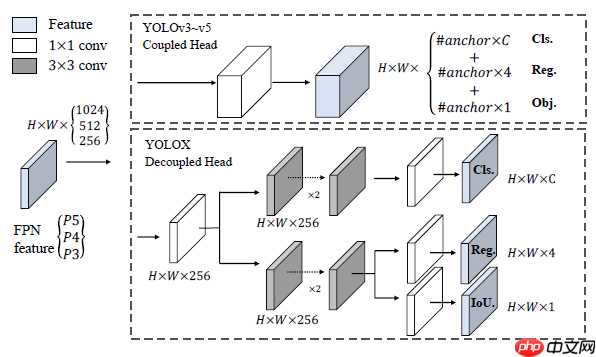
Anchor Free有以下几个好处:
Anchor Free技术目前可以上YOLO,且性能不降反升,与样本匹配有密不可分的联系。
样本匹配算法可以天然缓解拥挤场景检测问题、缓解极端长宽比的物体检测效果差的问题、极端大小目标正样本不均衡问题、缓解旋转物体检测效果不好的问题。
作者认为样本匹配中主要有四个重要因素:
数据增强方面延用Mosaic和Mixup数据增强技术,利用了四张图片进行拼接实现数据中增强,丰富了检测物体的背景。
Mosaic方法在YOLOv4中提出,主要思想是将四张图片进行随机裁剪,再拼接到一张图上作为训练数据。好处是丰富了图片背景,且四张图片拼接在一起变相提高batch_size,在进行batch normalization的时候也会计算四张图片,对本身batch_size不是很依赖。
具体可参考论文:YOLOv4: Optimal Speed and Accuracy of Object Detection
Mixup方法使用朴素的线性插值方法得到新扩展数据。
具体可参考论文:mixup: Beyond Empirical Risk Minimization
参考B站Up主Bubbliiiing绘制的网络结构图,网络整体可以分为三个部分:主干网络CSPDarknet、特征加强的PAN Head、检测头YOLO Head。
# 引入库import paddlefrom paddle import nn
基本卷积块包含卷积、批归一化和激活函数。基本卷积块采用等大填充Same Padding,包含一般卷积(BaseConv)和深度可分离卷积(DWConv)两种类型。
BaseConv结构示意
| Input |
|---|
| Conv2D |
| Batch Norm |
| Act |
Bottleneck残差卷积块,主干采用2个基本卷积块,卷积核大小分别为1和3,残差部分保持原输入,结果输出主干与残差边之和。
Bottleneck结构示意
| Input | |
|---|---|
| BaseConv 1x1 | Identity |
| BaseConv 3x3 | |
| Add | |
## 构建卷积块class BaseConv(nn.Layer):
def __init__(self, in_channels, out_channels, kernel_size, stride, groups=1, act='silu'):
super().__init__()
padding = (kernel_size-1)//2
self.conv = nn.Conv2D(in_channels, out_channels, kernel_size, stride, padding, groups=groups)
self.bn = nn.BatchNorm2D(out_channels,momentum=0.03, epsilon=0.001) if act == 'silu':
self.act = nn.Silu() elif act == 'relu':
self.act = nn.ReLU() elif act == 'lrelu':
self.act = nn.LeakyReLU(0.1) def forward(self, x):
return self.act(self.bn(self.conv(x)))## 构建深度可分离卷积class DWConv(nn.Layer):
# Some Problem
def __init__(self, in_channels, out_channels, kernel_size, stride=1, act='silu'):
super().__init__()
self.dconv = BaseConv(in_channels, in_channels, kernel_size, stride, groups=in_channels, act=act)
self.pconv = BaseConv(in_channels, out_channels, 1, 1, groups=1, act=act) def forward(self, x):
x = self.dconv(x) return self.pconv(x)## 构建残差结构class Bottleneck(nn.Layer):
def __init__(self, in_channels, out_channels, shortcut=True, expansion=0.5, depthwise=False, act="silu"):
super().__init__()
hidden_channels = int(out_channels * expansion)
Conv = DWConv if depthwise else BaseConv # 1x1卷积进行通道数的缩减(缩减率默认50%)
self.conv1 = BaseConv(in_channels, hidden_channels, 1, stride=1, act=act) # 3x3卷积进行通道数的拓张(特征提取)
self.conv2 = Conv(hidden_channels, out_channels, 3, stride=1, act=act)
self.use_add = shortcut and in_channels == out_channels def forward(self, x):
y = self.conv2(self.conv1(x)) if self.use_add:
y = y + x return y## 测试卷积模块x = paddle.ones([1, 3, 640, 640]) conv1 = BaseConv(3, 64, 3, 1) conv2 = DWConv(3, 64, 3, 1) block1 = Bottleneck(3, 64)print(conv1(x).shape)print(conv2(x).shape)print(block1(x).shape)
/opt/conda/envs/python35-paddle120-env/lib/python3.7/site-packages/paddle/nn/layer/norm.py:653: UserWarning: When training, we now always track global mean and variance. "When training, we now always track global mean and variance.")
[1, 64, 640, 640] [1, 64, 640, 640] [1, 64, 640, 640]
Focus最早在YOLOv5(并无论文)中提出,具体操作是在一张图片中每隔一个像素拿到一个值,类似于邻近下采样,这样就获得了四张图片,四张图片互补,将W、H信息集中到了通道空间C,输入通道扩充为4倍,拼接起来的图片相对于原先的RGB三通道模式变成了12个通道,最后将得到的新图片再经过卷积操作,最终得到了没有信息丢失情况下的二倍下采样特征图。
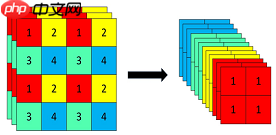
Focus作用是为了提速,作者提到使用Focus层可以减少参数计算,减少Cuda使用内存。
## Focus层class Focus(nn.Layer):
def __init__(self, in_channels, out_channels, ksize=1, stride=1, act="silu"):
super().__init__()
self.conv = BaseConv(in_channels * 4, out_channels, ksize, stride, act=act) def forward(self, x):
# 分别获得4个2倍下采样结果
patch_1 = x[..., ::2, ::2]
patch_2 = x[..., 1::2, ::2]
patch_3 = x[..., ::2, 1::2]
patch_4 = x[..., 1::2, 1::2] # 沿通道方向拼接4个下采样结果
x = paddle.concat((patch_1, patch_2, patch_3, patch_4), axis=1) # 拼接结果做卷积
out = self.conv(x) return out## 测试FOCUS模块x = paddle.ones([1, 3, 640, 640]) layer = Focus(3, 64)print(layer(x).shape)
[1, 64, 320, 320]
CSPLayer主要结构如下图所示,在常规结构基础上,引入一条类似残差结构的分支。
主干部分采用1个基本卷积块+堆叠N个Bottleneck残差块结构提取特征,残差部分采用1个基本卷积块,最后合并两个分支再作用一次基本卷积块。
CSPLayer结构示意
| Input | |
|---|---|
| BaseConv 1x1 | BaseConv 1x1 |
| Bottleneck(x N) | |
| Concat | |
| BaseConv 1x1 | |
## CSPLayerclass CSPLayer(nn.Layer):
def __init__(self, in_channels, out_channels, n=1, shortcut=True, expansion=0.5, depthwise=False, act="silu",):
super().__init__()
hidden_channels = int(out_channels * expansion)
# 主干部分的基本卷积块
self.conv1 = BaseConv(in_channels, hidden_channels, 1, stride=1, act=act) # 残差边部分的基本卷积块
self.conv2 = BaseConv(in_channels, hidden_channels, 1, stride=1, act=act) # 拼接主干与残差后的基本卷积块
self.conv3 = BaseConv(2 * hidden_channels, out_channels, 1, stride=1, act=act) # 根据循环次数构建多个残差块瓶颈结构
res_block = [Bottleneck(hidden_channels, hidden_channels, shortcut, 1.0, depthwise, act=act) for _ in range(n)]
self.res_block = nn.Sequential(*res_block) def forward(self, x):
# 主干部分
x_main = self.conv1(x)
x_main = self.res_block(x_main) # 残差边部分
x_res = self.conv2(x) # 主干部分和残差边部分进行堆叠
x = paddle.concat((x_main, x_res), axis=1)
# 对堆叠的结果进行卷积的处理
out = self.conv3(x) return out## 测试CSPLayer模块x = paddle.ones([1, 3, 640, 640]) layer = CSPLayer(3, 64, 5)print(layer(x).shape)
[1, 64, 640, 640]
SPPBottleneck主要结构如下图所示,采用卷积块1+4条通路+拼接+卷积块2的整体结构。
卷积块1将通道数缩减一半;4条通路下采样为原始输入和窗口大小分别为5,9,13的最大池化;沿通道方向拼接;卷积块2调整输出通道数。
SPPBottleneck结构示意
| Input | |||
|---|---|---|---|
| BaseConv 1x1 | |||
| Identity | MaxPool 5x5 | MaxPool 9x9 | MaxPool 13x13 |
| Concat | |||
| BaseConv 1x1 | |||
## SPPBottleneckclass SPPBottleneck(nn.Layer):
def __init__(self, in_channels, out_channels, kernel_sizes=(5, 9, 13), activation="silu"):
super().__init__()
hidden_channels = in_channels // 2
self.conv1 = BaseConv(in_channels, hidden_channels, 1, stride=1, act=activation)
self.pool_block = nn.Sequential(*[nn.MaxPool2D(kernel_size=ks, stride=1, padding=ks // 2) for ks in kernel_sizes])
conv2_channels = hidden_channels * (len(kernel_sizes) + 1)
self.conv2 = BaseConv(conv2_channels, out_channels, 1, stride=1, act=activation) def forward(self, x):
x = self.conv1(x)
x = paddle.concat([x] + [pool(x) for pool in self.pool_block], axis=1)
x = self.conv2(x) return x## 测试SPPBottleneck模块x = paddle.ones([1, 3, 640, 640]) layer = SPPBottleneck(3, 64)print(layer(x).shape)
[1, 64, 640, 640]
CSPDarknet为YOLOX的主干网络用于网络的特征提取,结果将输出三个特征层(输入为[3, 640, 640],三个特征层尺寸分别为[256, 80, 80], [512, 40, 40], [1024, 20, 20])。其主要结构如下图所示,其中主要涉及到的块如Focus、BaseConv、CSPLayer、SPPBottleneck均在上文实现,下面将这些部分组装起来:
CSPDarknet结构示意
| Input(-1, 3, 640, 640) | |||
|---|---|---|---|
| Focus | (-1, 12, 320, 320) | Stem | None |
| Conv | (-1, 64, 320, 320) | ||
| Conv | (-1, 128, 160, 160) | ResBlock1 | |
| CSPLayer | (-1, 128, 160, 160) | ||
| Conv | (-1, 256, 80, 80) | Resblock2 | |
| CSPLayer | (-1, 256, 80, 80) | feature[dark3] | |
| Conv | (-1, 512, 40, 40) | ResBlock3 | None |
| CSPLayer | (-1, 512, 40, 40) | feature[dark4] | |
| Conv | (-1, 1024, 20, 20) | ResBlock4 | None |
| SPPBottleneck | (-1, 1024, 20, 20) | ||
| CSPLayer | (-1, 1024, 20, 20) | feature[dark5] | |
## CSPDarknetclass CSPDarknet(nn.Layer):
def __init__(self, dep_mul, wid_mul, out_features=("dark3", "dark4", "dark5"), depthwise=False, act="silu",):
super().__init__() assert out_features, "please provide output features of Darknet"
self.out_features = out_features
Conv = DWConv if depthwise else BaseConv # Image Size : [3, 640, 640]
base_channels = int(wid_mul * 64) # 64
base_depth = max(round(dep_mul * 3), 1) # 3
# 利用focus网络特征提取
# [-1, 3, 640, 640] -> [-1, 64, 320, 320]
self.stem = Focus(3, base_channels, ksize=3, act=act) # Resblock1[dark2]
# [-1, 64, 320, 320] -> [-1, 128, 160, 160]
self.dark2 = nn.Sequential(
Conv(base_channels, base_channels * 2, 3, 2, act=act),
CSPLayer(base_channels * 2, base_channels * 2, n=base_depth, depthwise=depthwise, act=act),
) # Resblock2[dark3]
# [-1, 128, 160, 160] -> [-1, 256, 80, 80]
self.dark3 = nn.Sequential(
Conv(base_channels * 2, base_channels * 4, 3, 2, act=act),
CSPLayer(base_channels * 4, base_channels * 4, n=base_depth * 3, depthwise=depthwise, act=act),
) # Resblock3[dark4]
# [-1, 256, 80, 80] -> [-1, 512, 40, 40]
self.dark4 = nn.Sequential(
Conv(base_channels * 4, base_channels * 8, 3, 2, act=act),
CSPLayer(base_channels * 8, base_channels * 8, n=base_depth * 3, depthwise=depthwise, act=act),
) # Resblock4[dark5]
# [-1, 512, 40, 40] -> [-1, 1024, 20, 20]
self.dark5 = nn.Sequential(
Conv(base_channels * 8, base_channels * 16, 3, 2, act=act),
SPPBottleneck(base_channels * 16, base_channels * 16, activation=act),
CSPLayer(base_channels * 16, base_channels * 16, n=base_depth, shortcut=False, depthwise=depthwise, act=act),
) def forward(self, x):
outputs = {}
x = self.stem(x)
outputs["stem"] = x
x = self.dark2(x)
outputs["dark2"] = x # dark3输出特征层:[256, 80, 80]
x = self.dark3(x)
outputs["dark3"] = x # dark4输出特征层:[512, 40, 40]
x = self.dark4(x)
outputs["dark4"] = x # dark5输出特征层:[1024, 20, 20]
x = self.dark5(x)
outputs["dark5"] = x return {k: v for k, v in outputs.items() if k in self.out_features}## 测试CSPDarknet模块x = paddle.ones([1, 3, 640, 640]) net1 = CSPDarknet(1, 1)print(net1(x)['dark3'].shape, net1(x)['dark4'].shape, net1(x)['dark5'].shape)
[1, 256, 80, 80] [1, 512, 40, 40] [1, 1024, 20, 20]
YOLOPAFPN为YOLOX网络的特征加强部分,集成了FPN和PANET。通过将主干网络获得的三个特征层经过多次上采样和下采样进行特征融合,将不同尺度的特征信息进行结合。YOLOPAFPN的整体结构如下:
YOLOPAFPN结构示意
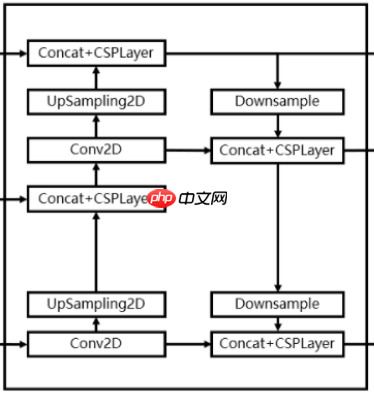
## YOLOPAFPNclass YOLOPAFPN(nn.Layer):
def __init__(self, depth = 1.0, width = 1.0, in_features = ("dark3", "dark4", "dark5"), in_channels = [256, 512, 1024], depthwise = False, act = "silu"):
super().__init__()
Conv = DWConv if depthwise else BaseConv
self.backbone = CSPDarknet(depth, width, depthwise = depthwise, act = act)
self.in_features = in_features
self.upsample = nn.Upsample(scale_factor=2, mode='nearest') # [-1, 1024, 20, 20] -> [-1, 512, 20, 20]
self.lateral_conv0 = BaseConv(int(in_channels[2] * width), int(in_channels[1] * width), 1, 1, act=act)
# [-1, 1024, 40, 40] -> [-1, 512, 40, 40]
self.C3_p4 = CSPLayer( int(2 * in_channels[1] * width), int(in_channels[1] * width), round(3 * depth), False,
depthwise = depthwise,
act = act
)
# [-1, 512, 40, 40] -> [-1, 256, 40, 40]
self.reduce_conv1 = BaseConv(int(in_channels[1] * width), int(in_channels[0] * width), 1, 1, act=act) # [-1, 512, 80, 80] -> [-1, 256, 80, 80]
self.C3_p3 = CSPLayer( int(2 * in_channels[0] * width), int(in_channels[0] * width), round(3 * depth), False,
depthwise = depthwise,
act = act
) # Bottom-Up Conv
# [-1, 256, 80, 80] -> [-1, 256, 40, 40]
self.bu_conv2 = Conv(int(in_channels[0] * width), int(in_channels[0] * width), 3, 2, act=act) # [-1, 512, 40, 40] -> [-1, 512, 40, 40]
self.C3_n3 = CSPLayer( int(2 * in_channels[0] * width), int(in_channels[1] * width), round(3 * depth), False,
depthwise = depthwise,
act = act
) # [-1, 512, 40, 40] -> [-1, 512, 20, 20]
self.bu_conv1 = Conv(int(in_channels[1] * width), int(in_channels[1] * width), 3, 2, act=act) # [-1, 1024, 20, 20] -> [-1, 1024, 20, 20]
self.C3_n4 = CSPLayer( int(2 * in_channels[1] * width), int(in_channels[2] * width), round(3 * depth), False,
depthwise = depthwise,
act = act
) def forward(self, input):
out_features = self.backbone(input)
[feat1, feat2, feat3] = [out_features[f] for f in self.in_features] # [-1, 1024, 20, 20] -> [-1, 512, 20, 20]
P5 = self.lateral_conv0(feat3) # [-1, 512, 20, 20] -> [-1, 512, 40, 40]
P5_upsample = self.upsample(P5) # [-1, 512, 40, 40] + [-1, 512, 40, 40] -> [-1, 1024, 40, 40]
P5_upsample = paddle.concat([P5_upsample, feat2], axis=1) # [-1, 1024, 40, 40] -> [-1, 512, 40, 40]
P5_upsample = self.C3_p4(P5_upsample) # [-1, 512, 40, 40] -> [-1, 256, 40, 40]
P4 = self.reduce_conv1(P5_upsample)
# [-1, 256, 40, 40] -> [-1, 256, 80, 80]
P4_upsample = self.upsample(P4)
# [-1, 256, 80, 80] + [-1, 256, 80, 80] -> [-1, 512, 80, 80]
P4_upsample = paddle.concat([P4_upsample, feat1], axis=1)
# [-1, 512, 80, 80] -> [-1, 256, 80, 80]
P3_out = self.C3_p3(P4_upsample)
# [-1, 256, 80, 80] -> [-1, 256, 40, 40]
P3_downsample = self.bu_conv2(P3_out)
# [-1, 256, 40, 40] + [-1, 256, 40, 40] -> [-1, 512, 40, 40]
P3_downsample = paddle.concat([P3_downsample, P4], axis=1)
# [-1, 512, 40, 40] -> [-1, 512, 40, 40]
P4_out = self.C3_n3(P3_downsample)
# [-1, 512, 40, 40] -> [-1, 512, 20, 20]
P4_downsample = self.bu_conv1(P4_out) # [-1, 512, 20, 20] + [-1, 512, 20, 20] -> [-1, 1024, 20, 20]
P4_downsample = paddle.concat([P4_downsample, P5], axis=1) # [-1, 1024, 20, 20] -> [-1, 1024, 20, 20]
P5_out = self.C3_n4(P4_downsample) return (P3_out, P4_out, P5_out)## 测试YOLOPAFPN模块features = paddle.ones([1, 256, 80, 80]), paddle.ones([1, 512, 40, 40]), paddle.ones([1, 1024, 20, 20]) net2 = YOLOPAFPN()print(net2(x)[0].shape, net2(x)[1].shape, net2(x)[2].shape)
[1, 256, 80, 80] [1, 512, 40, 40] [1, 1024, 20, 20]
YOLOX Head时YOLOX网络的检测头,同时起到分类器与回归器的作用,相比于传统的yolo检测头,yolox head检测头是解耦的,将分类和回归分为两个分支进行处理,最后预测的时候再进行整合,加强了网络的识别能力。
YOLOX Head结构示意
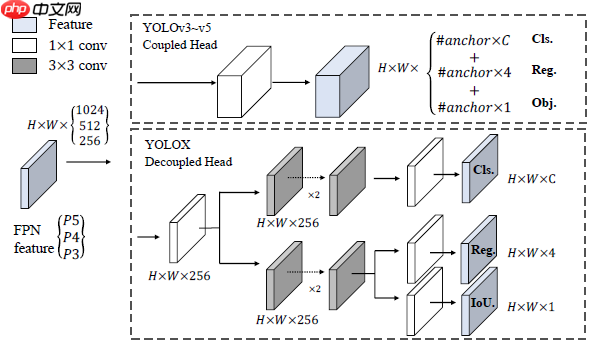
## YOLOX Headclass YOLOXHead(nn.Layer):
def __init__(self, num_classes, width = 1.0, in_channels = [256, 512, 1024], act = "silu", depthwise = False,):
super().__init__()
Conv = DWConv if depthwise else BaseConv
self.cls_convs = []
self.reg_convs = []
self.cls_preds = []
self.reg_preds = []
self.obj_preds = []
self.stems = [] for i in range(len(in_channels)): # 预处理卷积: 1个1x1卷积
self.stems.append(BaseConv(in_channels = int(in_channels[i] * width), out_channels = int(256 * width), kernel_size = 1, stride = 1, act = act)) # 分类特征提取: 2个3x3卷积
self.cls_convs.append(nn.Sequential(*[
Conv(in_channels = int(256 * width), out_channels = int(256 * width), kernel_size= 3, stride = 1, act = act),
Conv(in_channels = int(256 * width), out_channels = int(256 * width), kernel_size= 3, stride = 1, act = act),
])) # 分类预测: 1个1x1卷积
self.cls_preds.append(
nn.Conv2D(in_channels = int(256 * width), out_channels = num_classes, kernel_size = 1, stride = 1, padding = 0)
)
# 回归特征提取: 2个3x3卷积
self.reg_convs.append(nn.Sequential(*[
Conv(in_channels = int(256 * width), out_channels = int(256 * width), kernel_size = 3, stride = 1, act = act),
Conv(in_channels = int(256 * width), out_channels = int(256 * width), kernel_size = 3, stride = 1, act = act)
])) # 回归预测(位置): 1个1x1卷积
self.reg_preds.append(
nn.Conv2D(in_channels = int(256 * width), out_channels = 4, kernel_size = 1, stride = 1, padding = 0)
) # 回归预测(是否含有物体): 1个1x1卷积
self.obj_preds.append(
nn.Conv2D(in_channels = int(256 * width), out_channels = 1, kernel_size = 1, stride = 1, padding = 0)
) def forward(self, inputs):
# 输入[P3_out, P4_out, P5_out]
# P3_out: [-1, 256, 80, 80]
# P4_out: [-1, 512, 40, 40]
# P5_out: [-1, 1024, 20, 20]
outputs = [] for k, x in enumerate(inputs): # 1x1卷积通道整合
x = self.stems[k](x) # 2个3x3卷积特征提取
cls_feat = self.cls_convs[k](x) # 1个1x1卷积预测类别
# 分别输出: [-1, num_classes, 80, 80], [-1, num_classes, 40, 40], [-1, num_classes, 20, 20]
cls_output = self.cls_preds[k](cls_feat) # 2个3x3卷积特征提取
reg_feat = self.reg_convs[k](x) # 1个1x1卷积预测位置
# 分别输出: [-1, 4, 80, 80], [-1, 4, 40, 40], [-1, 4, 20, 20]
reg_output = self.reg_preds[k](reg_feat) # 1个1x1卷积预测是否有物体
# 分别输出: [-1, 1, 80, 80], [-1, 1, 40, 40], [-1, 1, 20, 20]
obj_output = self.obj_preds[k](reg_feat) # 整合结果
# 输出: [-1, num_classes+5, 80, 80], [-1, num_classes+5, 40, 40], [-1, num_classes+5, 20, 20]
output = paddle.concat([reg_output, obj_output, cls_output], 1)
outputs.append(output) return outputs## 测试YOLOX Head模块features = paddle.ones([1, 256, 80, 80]), paddle.ones([1, 512, 40, 40]), paddle.ones([1, 1024, 20, 20]) net3 = YOLOXHead(10)print(net3(features)[0].shape, net3(features)[1].shape, net3(features)[2].shape)
[1, 15, 80, 80] [1, 15, 40, 40] [1, 15, 20, 20]
class YoloBody(nn.Layer):
def __init__(self, num_classes, kind):
super().__init__()
depth_dict = {'nano': 0.33, 'tiny': 0.33, 's' : 0.33, 'm' : 0.67, 'l' : 1.00, 'x' : 1.33,}
width_dict = {'nano': 0.25, 'tiny': 0.375, 's' : 0.50, 'm' : 0.75, 'l' : 1.00, 'x' : 1.25,}
depth, width = depth_dict[kind], width_dict[kind]
depthwise = True if kind == 'nano' else False
self.backbone = YOLOPAFPN(depth, width, depthwise=depthwise)
self.head = YOLOXHead(num_classes, width, depthwise=depthwise) def forward(self, x):
fpn_outs = self.backbone.forward(x)
outputs = self.head.forward(fpn_outs) return outputs## 测试YOLO Body模块x = paddle.ones([1, 3, 640, 640]) net4 = YoloBody(10, 'x')print(net4(x)[0].shape, net4(x)[1].shape, net4(x)[2].shape)
[1, 15, 80, 80] [1, 15, 40, 40] [1, 15, 20, 20]
以上就是基于Paddle框架的YOLOX构建的详细内容,更多请关注php中文网其它相关文章!

每个人都需要一台速度更快、更稳定的 PC。随着时间的推移,垃圾文件、旧注册表数据和不必要的后台进程会占用资源并降低性能。幸运的是,许多工具可以让 Windows 保持平稳运行。

Copyright 2014-2025 https://www.php.cn/ All Rights Reserved | php.cn | 湘ICP备2023035733号